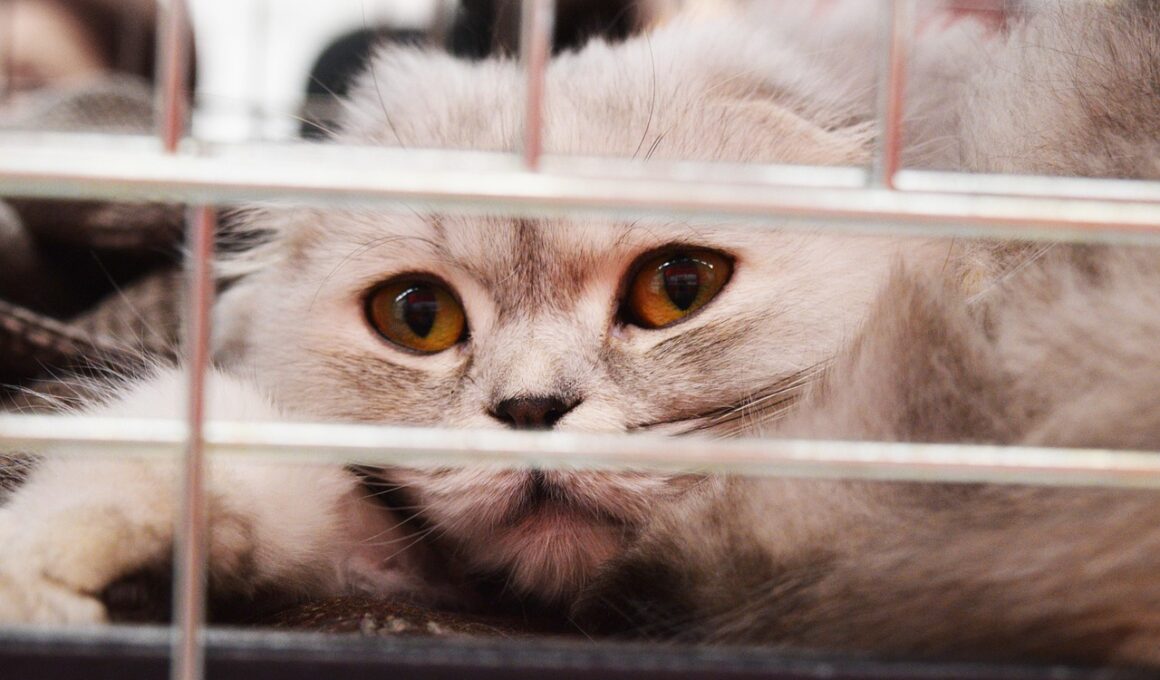Challenges and Solutions in Socializing Shelter Cats
Socializing shelter cats is a complex issue that many shelters face. Unlike dogs, felines are often more solitary by nature and may be even more wary of human interactions. The biggest challenge is overcoming their initial fear, which can stem from past trauma or a lack of early socialization. To assist in the rehabilitation of these cats, shelters often employ various strategies aimed at slowly acclimating them to human contact. One common method involves a dedicated socialization area within the shelter, where staff can interact with the cats in a safe space. Additionally, utilizing scent and sound enrichment can help ease their anxiety. It’s essential to provide a comforting environment that allows them to feel secure. This can include cozy hiding spots and gentle music to soothe their nerves. Creating positive associations with human presence is vital, often achieved through treats and gentle play. Ultimately, understanding a cat’s individual needs and pacing the introduction process are key to achieving successful socialization outcomes. By addressing these challenges with tailored solutions, shelters can help transform fearful felines into loving companions for future adopters.
Another major hurdle in socializing shelter cats is their unique temperamental differences. While some cats may quickly warm up to strangers, others can be extremely shy or fearful, complicating the process. For shelter staff and volunteers, recognizing these differences is crucial for implementing effective socialization techniques. Typically, it begins with patience and an understanding approach. Initially, it is advisable to allow cats to explore their environment and choose when to interact. This self-directed approach respects the cat’s boundaries and reduces stress. Furthermore, utilizing a gradual desensitization strategy can be beneficial. This involves slowly introducing new stimuli to the cat, such as gentle touch or the sound of a person’s voice. Creating a routine where the cat receives regular positive interactions, like treats or playtime, can further establish trust. Socialization efforts should also include teamwork among shelter staff, ensuring everyone is on the same page with techniques. Regular evaluations can help pinpoint which cats may need extra attention. In collaboration, shelters can identify specific needs and provide personalized care. By understanding these temperamental nuances, shelters enhance the chances for successful and fulfilling adoptions.
Moreover, the physical environment within a shelter plays a significant role in cat socialization. Loud noises, frequent visitor traffic, and the presence of unfamiliar animals can contribute to stress and anxiety. To create a more inviting atmosphere, shelters can implement quiet zones specifically designated for shy or unsocialized cats. These areas should provide comfort through proper bedding, escapes, and low lighting. Additionally, implementing low-stress handling techniques can also aid in minimizing anxiety during socialization efforts. For example, using calming pheromones may help create a sense of security for anxious cats, making them more open to interaction. Moreover, offering various stimuli such as toys and climbing structures can help divert attention from stressful situations. Proper placement of resources, like food and litter boxes, should also be considered to avoid added stress during meal times. Adequate space between cats is necessary, as overcrowding can hinder socialization progress. By creating a stress-reduced environment, shelters can significantly enhance the socialization opportunities for cats. These tailored approaches can lead to more successful adoptions, ultimately resulting in healthier and happier feline companions finding forever homes.
Importance of Volunteer Training
Volunteer involvement plays an essential role in the socialization of shelter cats. However, untrained volunteers might inadvertently exhibit behaviors that could hinder a cat’s progress. Therefore, providing comprehensive training to volunteers is critical. This training should emphasize understanding cat body language and signs of stress, ensuring volunteers can approach cats appropriately. Additionally, teaching volunteers effective handling techniques can prevent mishandling, thereby boosting a cat’s confidence during interactions. Volunteers should also learn how to read individual cat personalities, allowing them to tailor their approach to each feline. Furthermore, involving volunteers in socialization sessions creates more frequent opportunities for cats to interact positively with humans. Volunteer-led programs can also be designed, focusing on the gradual introduction of adoptable cats to visitors in a calm manner. By engaging volunteers in the socialization process, shelters not only increase the level of attention each cat receives, but also promote a sense of community and connection among adopters. Ultimately, empowering volunteers equips them with the skills to help cats thrive socially, benefitting overall animal welfare within shelter environments.
Another aspect of effective socialization involves ongoing evaluation and follow-up programs for newly adopted cats. It’s common for shelters to neglect this essential part after a cat leaves the shelter environment. However, a simple follow-up can provide valuable insights and support for adopters. By checking in with families after adoption, shelters can assess how the cat is acclimating to their new surroundings. This feedback can highlight any areas of concern, allowing shelters to offer guidance for continuing socialization processes. Furthermore, developing resource materials, like brochures with tips for new cat owners, can help facilitate successful adjustments. Encouraging open communication between shelters and adopters generates a supportive network that fosters long-term success. Additionally, hosting community workshops on cat behavior and training can further educate new owners. By equipping adopters with the necessary tools and knowledge, shelters can significantly reduce the chances of returned animals due to behavioral issues. Ultimately, continuous support after adoption contributes to the positive outcomes of cat socialization efforts, ensuring felines transition smoothly into their new homes and enhance their well-being.
Utilizing Technology in Socialization
Recent advancements in technology provide innovative solutions for the socialization of shelter cats. Virtual reality, for example, allows potential adopters to experience a simulated environment that showcases the cats’ behaviors in a safe setting. This technology can be beneficial in drawing visitors into the shelter and encourages them to spend time with the cats. Additionally, social media platforms have become advantageous for shelters. By showcasing individual cats’ personalities and socialization progress videos, shelters can engage with a broader audience and increase visibility for adoptable pets. Furthermore, interactive online resources, like webinars or virtual workshops, can educate the public on effective cat handling techniques. By using these technological tools, shelters can connect with prospective adopters, fostering greater awareness about cat behavior. Apps can also be developed that help to track the socialization progress of cats, allowing shelters to document successful techniques. Overall, integrating technology into socialization strategies creates more opportunities for meaningful interactions between cats and their future families. This approach ultimately facilitates a smoother transition and enhances the likelihood of successful adoption.
Finally, understanding the potential challenges associated with the dual roles of being a shelter and socializing space is crucial. Many shelters struggle with limited resources, staffing, and space constraints. To effectively socialize cats, shelters often need to prioritize resources and allocate funds strategically. Fundraising efforts focused on socialization programs can significantly enhance training and equipment to support these initiatives. Collaborating with local schools and community organizations can also aid in gaining additional volunteer support. Shelters can host events to inform the public about the importance of investing in socialization for cats. Community sponsorships can finance additional programs geared towards education and awareness about the significance of helping shelter cats find homes. By promoting and advocating for socialization efforts, shelters build stronger relationships with local communities. Enhanced partnerships lead to a better understanding of the challenges faced by shelters, allowing for effective solutions to address weaknesses. Overall, addressing these challenges collaboratively fosters a caring community, ensuring that every cat receives the attention they deserve during the crucial socialization process, resulting in improved adoption outcomes.



